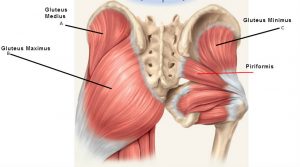ADVICE
Gluteus Medius; Another Source of Back Pain
We’ve talked before about the quadratus lumborum (QL) and its association with low back pain. Well, one of the QL’s partners in crime (I’m afraid there are more than one) is the gluteus medius, which is known as the “Low Back Pain” muscle, because it is prevalent in the causes of low back pain.
Pain in the lower back and hip region whilst walking, or discomfort when lying on your side, may be evidence that your gluteus medius is dysfunctional.
The gluteus medius lies between the gluteus maximus, the most superficial of the glutes, and the gluteus minimus, the deepest of the glutes. It attaches along the top of the iliac crest of the pelvis (where you rest your hands on your hips), and continues down to the top of the femur, creating a fan shape. Its primary function is to stabilise the hip by keeping the hip level whilst standing on one leg, which it will do every time you take a step walking or running – so it works hard! It also lifts the leg sideways away from the body. You can feel it contract by standing up straight, placing your thumbs into the flesh below the iliac crest on either side and gently rocking your weight from one foot to the other.
There are three trigger points that can be activated on the gluteus medius, and they radiate pain along the belt line, into the sacro-iliac joint, down into the buttock and sometimes the back of the thigh. If you manage to locate a trigger point through gentle poking around the area of the muscle, you’ll be able to replicate the pain you experience in causative situations by pushing more deeply into the muscle. Gluteus medius dysfunction can be misdiagnosed as sacro-iliac joint dysfunction, sciatica, or even bursitis of the trochanter.
How do the problems begin? As you know, muscles are there to create movement and they dislike being inactive. Sitting for prolonged periods holds the gluteus medius in a static stretched position at the back of the muscle, and a contracted position at the front, which over time causes dysfunction. The negative effect is exacerbated if you sit with a wallet in the back pocket or with crossed legs. Conversely, overloading the muscle during activities like running, playing football or tennis and even walking on sand can initiate problems, particularly if your activity levels are increased suddenly or the activity takes place infrequently amongst days spent being mainly sedentary.
So, what’s the solution? If lying on your side is uncomfortable, sleeping with a pillow between your knees can help by keeping the hip in a more neutral position. However, for longer term solutions the most effective treatment is massage, either with a therapist, or with self-massage.
As well as treating the symptoms, a good massage therapist should be able to advise on related muscle imbalances and recommend an exercise plan to address these and help prevent future occurrence.
Self-massage is also very effective; first locate the tender points with your fingers, then place a tennis ball on the tender spot and lean onto the ball against a wall. Take the weight off the leg being treated to enable the muscle to relax and be manipulated. Gently move over the ball, pausing when you find a point of exquisite tenderness until the pain level drops and then continue the massage for up to a minute. You can also try lying on the ball on the ground for a more intense massage.

